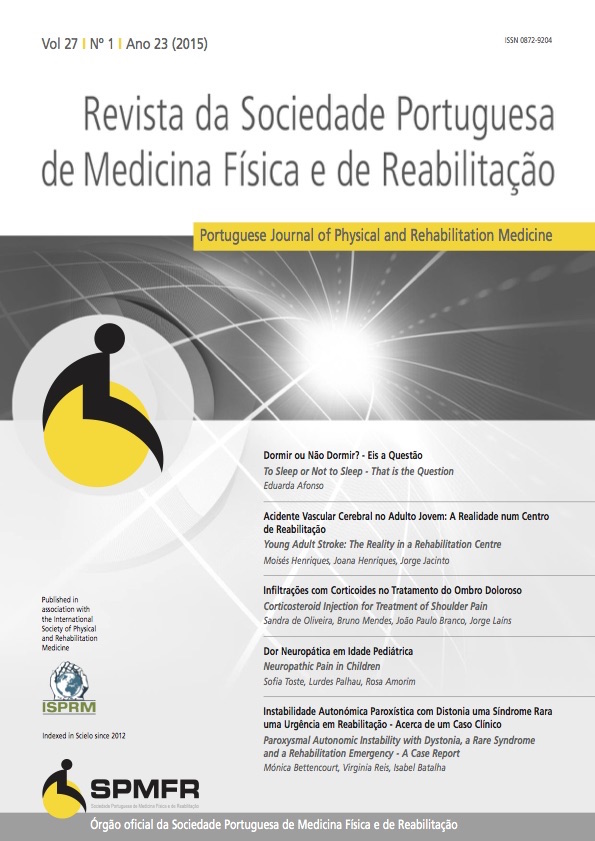Paroxysmal Autonomic Instability with Dystonia, a Rare Syndrome and a Rehabilitation Emergency - A Case Report
DOI:
https://doi.org/10.25759/spmfr.183Keywords:
Autonomic Nervous System Diseases/rehabilitation, Child, DystoniaAbstract
Introduction: Paroxysmal autonomic instability with dystonia is a relatively rare complication of multiple central nervous system (CNS) lesions. It remains poorly understood, despite its unfavorable clinical picture. It is associated with significant morbidity and mortality, increased length of stay in rehabilitation centers and unfavorable functional outcome. As it is difficult to differentiate from other conditions that also put patient`s lives at risk it is necessary for doctors to be aware for this syndrome. Persistent autonomic dysfunction may result in secondary brain injury and may be fatal.
Case Report: Five years old, male, victim of prolonged cardiac arrest due to near drowning, resulting in severe anoxic encephalopathy with neuromotor and cognitive-perceptual sequelae. Admitted in a rehabilitation center a month later, in a minimally consciousness state, he started several episodes of dystonia in descerebrate posture associated with tachycardia, diaphoresis, and persistent crying, triggered by different stimuli. This syndrome was a real clinical challenge, interfering with rehabilitation.
Discussion: This rare entity remains seldom considered in clinical practice and is associated with significant morbidity and mortality, extensive use of diagnostic tests and inadequate therapy in the rehabilitation context of these patients. The prompt recognition and treatment are crucial to prevent secondary brain injury.
Downloads
References
Scutariu M, Kakucs C, Oslobanu A, Florian I. Paroxysmal autonomic instability with dystonia after severe traumatic brain injury – a case
report. Rom Neurosurg. 2011; 28: 511-6.
Baguley J, Slewa-Younan S, Heriseanu R, Nott M, Mudaliar Y, Nayyar V. The incidence of disautonomia and its relationship with
autonomic arousal following traumatic brain injury. Brain Inj. 2007; 21:1175-81.
Blackman J, Patrick P, Buck M, Rust R. Paroxysmal autonomic instability with dystonia after brain injury. Arch Neurol. 2004;61:321-
Baguley I, Nicholls J, Felmingham K, Crooks J, Gurka J, Wade L. Dysautonomia after traumatic brain injury: a forgotten syndrome? J
Neurol Neurosurg Psychiatry. 1999; 67:39-43
Hendricks H, Heeren A, Vos P. Dysautonomia after severe traumatic brain injury. Eur J Neurol. 2010; 17:1172-77.
Safadieh L, Sharara-Chami R, Dabbagh O. Paroxysmal autonomic instability with dystonia after pneumococcal meningoencephalitis.
Case Rep Med. 2012; 4:304.
Tanti A, Gasperini G, Rossini M. Paroxysmal episodic hypothalamic instability with hypothermia after traumatic brain injury. Brain Inj.
; 19: 1277-83.
Kanjwal K, Karabin B, Kanjwal Y, Grubb B. Autonomic dysfunction presenting as postural tachycardia syndrome following traumatic
brain injury. Cardiol J. 2010; 17: 482-7.
Srinivasan S, Lim C, Thirugnamam U. Paroxysmal Autonomic Instability with Dystonia. Clin Auton Res. 2007; 17:378-81.
Ramdhani N, Sikma M, Witkamp T, Slooter A, Lange D. Paroxysmal autonomic instability with dystonia in a patient with tuberculous
meningitis: a case report. J Med Case Rep. 2010; 4:304
Kapoor D, Singla D, Singh J, Jindal R. Paroxysmal autonomic instability with dystonia (PAID) syndrome following cardiac arrest.
Singapore Med J. 2014 ;55:e123-5.
Wang V, Manley G. Recognition of Paroxysmal Autonomic Instability with Dystonia (PAID) in a Patient with Traumatic Brain Injury. J
Trauma. 2008; 64:500-2.
Goddeau R, Silverman S, Sims J. Dexmedetomidine for the treatment of paroxysmal autonomic instability with dystonia. Neurocrit
Care. 2007; 7:217-20.
Becker R, Benes L, Sure U, Hellwig D, Bertalanffy H. Intrathecal baclofen alleviates autonomic dysfunction in severe brain injury. J
Clin Neurosci. 2000; 7:316-9.
Downloads
How to Cite
Issue
Section
License
Copyright statement
Authors must also submit a copyright statement (as seen below) on article submission.
To the Editor-in-chief of the SPMFR Journal:
The below signed author(s) hereby state that the article
________________________________________ (ref. MFR_________) is
an original unpublished work and all facts stated are a product of the author(s) investigation. This article does not violate any copyright laws or privacy statements. The author(s) also hereby confirm that there is no conflict of interest's issues in this article.
By submitting this article the author(s) agree that after publication all copyrights belong to the SPMFR Journal.
Signed by all authors
Date:
Names (capital letters):
Signatures:
The SPMFR Journal’s contents are follow a Creative Commons licence. After publication the authors can hand out the articles as long as the SPMFR Journal is credited.



